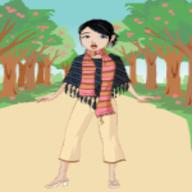關於Cheetahs的問題
2007-04-06 7:25 am
請詳細列出Cheetahs的資料!盡快!盡量用英文!
回答 (1)
2007-04-06 7:44 am
✔ 最佳答案
The cheetah has a slender, long-legged body with blunt non-retractable claws. Its chest is deep and its waist is narrow. Its coat is tan with small, round, black spots, and the fur is coarse and short. The cheetah has a small head with high-set eyes. Black "tear marks" run from the corner of its eyes down the sides of the nose to its mouth to keep sunlight out of its eyes and to aid in hunting and seeing long distances.The adult animal weighs from 40 to 65 kg (90 to 140 lb). Its total body length is from 112 to 135 cm (45 in to 55 in), while the tail can measure up to 84 cm (33 in). Males tend to be slightly larger than females and have slightly bigger heads, but there is great variation in cheetah sizes and it is difficult to tell males and females apart by appearance alone.
The fur of the cheetah is tan with round black spots in order to help camouflage it. The cheetah's black spots measure from 2-3 cm (¾ to 1¼ inches) across. There are no spots on its white belly, however, the tail has spots, which merge to form four to six dark rings at the end. The cheetah's tail usually ends in a bushy white tuft.
Some cheetahs also have a rare fur pattern mutation: cheetahs with larger, blotchy, merged spots are known as 'king cheetahs'. It was once thought to be a separate subspecies, but it is merely a mutation of the African cheetah. The 'king cheetah' has only been seen in the wild a handful of times, but it has been bred in captivity.
The cheetah's paws have non-retractable claws (known only in two other cat species - the Fishing Cat and the Iriomote Cat) offering the cat extra grip in its high-speed pursuits. The ligament structure of the cheetah's claws is the same as those of other cats; it simply lacks the sheath of skin and fur present in other varieties, and therefore the claws are always visible. With the exception of the dewclaw, the claw itself is also much shorter and straighter than other cats.
Adaptations that enable the cheetah to run as fast as it does include large nostrils that allow for optimal oxygen intake, and an enlarged heart and lungs that work together to circulate oxygen efficiently. While running, in addition to having good traction due to its semi-retractable claws, the cheetah uses its tail as a rudder-like means of steering to allow it to make sharp turns, necessary to outflank prey who often make such turns to escape.
Unlike "true" big cats, the cheetah can purr as it inhales, but cannot roar. By contrast, the big cats can roar but cannot purr, except while exhaling. However, the cheetah is still considered by some to be the smallest of the big cats. While it is often mistaken for the leopard, the cheetah does have distinguishing features, such as the aforementioned long "tear-streak" lines on each side of its nose that run from the corner of its eyes to its mouth. The body frame of the cheetah is also very different from that of the Leopard, most notably so in its thinner and extra long tail.
The cheetah is a vulnerable species. Out of all the big cats, it is the least able to adapt to new environments. It has always proved difficult to breed in captivity, although recently a few zoos have been successful. Once widely shot for its fur, the cheetah now suffers more from the loss of both habitat and prey.
The cheetah is considered the most primitive of all cats, and until recently was thought to have evolved approximately 18 million years ago, although new research puts the last common ancestor of all 40 existing species of feline more recently, at 11 million years. The cheetah's natural enemies are the lion, hyenas, and the leopard.
收錄日期: 2021-04-12 21:35:39
原文連結 [永久失效]:
https://hk.answers.yahoo.com/question/index?qid=20070405000051KK05117

